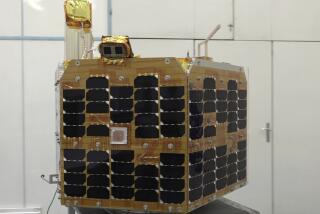Satellite Expected to Light Up Magnetic Fields During Study
- Share via
CAPE CANAVERAL, Fla. — A newly repaired unmanned rocket blasted into space Wednesday with a satellite that will use chemicals to transform Earth’s invisible magnetic field lines into brilliant bursts of color.
The 143-foot Atlas rocket roared into a clear sky, and the satellite separated from the booster 28 minutes after launch, drawing applause at the control center.
It was the fourth attempt by the National Aeronautics and Space Administration and rocket builder General Dynamics to launch the Atlas, the first commercial version of the rocket ever flown.
“We have about the best flight we could possibly hope for,” launch commentator George Diller said.
Monday’s scheduled launch was called off after the Atlas failed to transfer power just before liftoff. A corroded power transfer switch in the rocket was replaced.
Four liquid helium vent ducts were replaced a few days earlier. One of them slipped off an engine outlet in the rocket’s upper-stage thrust section, forcing postponement of Friday’s launch attempt. Threatening thunderstorms caused Sunday’s delay.
The weather was perfect Wednesday as the Atlas boosted the $189-million Combined Release and Radiation Effects Satellite to an elliptical orbit 217 miles by 22,236 miles high to study radiation in space.
The two-ton satellite holds 24 chemical-filled canisters that will be released starting this fall. A 25-minute timer in each canister will release barium, lithium and other chemicals in vapor form once the spacecraft is at a safe distance.
Ultraviolet rays from the sun will ionize the chemicals, creating glowing clouds that will spread along Earth’s magnetic field lines.
The barium-laden clouds will resemble the aurora borealis, or the northern lights. All of the displays will be visible to the naked eye. Scientists will be able to measure electric fields and see how they interact with normally invisible charged particles.
More to Read
Sign up for Essential California
The most important California stories and recommendations in your inbox every morning.
You may occasionally receive promotional content from the Los Angeles Times.












